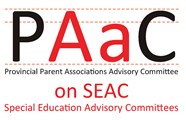Many SEAC members are volunteers, who may be parents of students with special education needs. SEAC members may have diverse backgrounds in terms of education, culture and experience and some may have limited committee experience. SEAC members need to be clear about meeting expectations and meeting processes in order to become effective participants in SEAC meetings. (See also Section 5 on Meeting Processes).
PAAC on SEAC has identified some of the key skills that are useful for SEAC members, including:
- Communication
- Presentation
- Team Building
- Problem Solving
- Time management
- Note taking
- Listening
- Assertiveness
- Decision Making
- Negotiation
- Research
- Organization
SEAC training sessions, a SEAC Orientation Manual and meeting strategies can all be used to help SEAC members improve their participation and contribution.
Effective Practices to support SEAC Member participation include:
- Developing or sharing a Code of Conduct for members, or meeting norms, that outline expectations and if necessary, consequences. (See also Table 5 for examples of meeting expectations.)
- Providing SEAC members with meeting documents 5 business days before the meeting.
- Indicating on the Agenda when an item is presented for decision making and providing templates or tools to help identify options and implications of choices.
- Providing SEAC members, staff and guests who are making presentations with clear direction on purpose and content as well as time limits. For example, linking the presentation to the Special Education Plan, BIPSA or Board Strategic Plan.
- Requesting presenters provide handouts with summary information with key ideas or facts in bold print or bulleted lists.
- Encouraging presenters to organize information into blocks with frequent stops to check that members have heard and understood materials.
- Ensuring presenters are clear about what they want from SEAC by providing discussion questions or options, including time for discussion or small group activities.
- Including time limits for presentations, or a time keeper, to make sure presentations are not too long or detailed.
- Providing SEAC members with a feedback form to complete for each presentation.
- Assisting SEAC members to make presentations at SEAC by providing an outline or list of questions to frame the presentations; a presentation template, opportunities to present to smaller groups.
The Ministry of Education has developed a resource guide that can be used at SEAC, Shared Solutions, A Guide to Preventing and Resolving Conflicts Regarding Programs and Services for Students with Special Education Needs (2007). This document includes information and strategies to understand conflict, build positive climates, to listen and communicate effectively. Many of the charts and tips can be shared with SEAC, included in a SEAC Orientation Manual or used in training sessions. Some school boards have developed training activities using Shared Solutions for staff, and many of the same exercises can be used in SEAC training.
In Table 4, there is a list of questions for SEAC members to ask themselves when they are preparing for a SEAC meeting.
Table 4: Preparation Checklist for SEAC Meeting
|
The “W” Questions |
The “HOW’” Questions |
| Where is the meeting? | How do I contribute to SEAC? |
| When is the meeting? | How do I acquire information? |
| What is the purpose of the meeting? | How do I share information? |
| Why am I going? | How do I use the information? |
| What do I want to accomplish at the meeting? | How do I encourage others to participate? |
| What information should I take with me? | How do I learn and listen effectively? |
| What issues do I want discussed? | How do I encourage the board and other SEAC members to investigate all options? |
| What am I going to report about my association? | How do I acquire feedback? |
| What information do I want to leave with after the meeting? | How do we support a process which will encourage feedback and follow through by SEAC members and the school board administration and Trustees? |
| What will I do with the information I have gained? |
SEAC members should arrive at SEAC meetings on time, and prepared with relevant information, having read the Agenda and support documents provided at least 3 days prior to the meeting. To help set the tone at meetings, the school board can prepare or share materials on a Code of Conduct, or meeting norms. Table 5 shows some examples of meeting expectations or meeting norms.
Table 5: Examples of Meeting Expectations or Norms
| Establish Expectations for Members |
|
| Establish Procedures for the Meeting |
|
| During Presentations or Discussions |
|
| At end of meeting |
|
